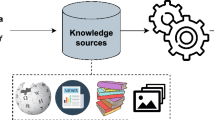Abstract
The NLP relies heavily on question answering. It provides an automated method for retrieving responses from a context. Finding context from several documents, studies, and testimonials is becoming increasingly important. Because NLP models for question answering are quite sophisticated and resource intensive, the purpose of this study is to provide a novel lightweight method to question answering in NLP by introducing the knowledge graph as input to the transfer learning model of T5. This study provides an overall holistic perspective of the suggested model’s various parameters.
Access this chapter
Tax calculation will be finalised at checkout
Purchases are for personal use only
Similar content being viewed by others
References
Allam, A., & Haggag, M. (2012). The question answering systems: A survey. International Journal of Research and Reviews in Information Sciences, 2, 211–221.
Abdi, A., Idris, N., & Ahmad, Z. (2018). QAPD: An ontology-based question answering system in the physics domain. Soft Computing, 22, 213–230.
Devlin, J., Chang, M., Lee, K., & Toutanova, K. (2018). BERT: Pre-training of deep bidirectional transformers for language understanding. arXiv:1810.04805
Hogan, A., Blomqvist, E., Cochez, M., D’amato, C., Melo, G., Gutierrez, C., Kirrane, S., Gayo, J., Navigli, R., Neumaier, S., Ngomo, A., Polleres, A., Rashid, S., Rula, A., Schmelzeisen, L., Sequeda, J., Staab, S., & Zimmermann, A. (2022). Knowledge graphs. ACM Computing Surveys, 54, 1–37. https://doi.org/10.1145/3447772
Yang, Z., Dai, Z., Yang, Y., Carbonell, J., Salakhutdinov, R., & Le, Q. (2019). XLNet: Generalized autoregressive pretraining for language understanding. In Advances in neural information processing systems (Vol. 32).
Raffel, C., Shazeer, N., Roberts, A., Lee, K., Narang, S., Matena, M., Zhou, Y., Li, W., & Liu, P. (2019). Exploring the limits of transfer learning with a unified text-to-text transformer. ArXiv:1910.10683
Lan, Z., Chen, M., Goodman, S., Gimpel, K., Sharma, P., & Soricut, R. (2019). ALBERT: A lite BERT for self-supervised learning of language representations. arXiv:1909.11942
Clark, K., Luong, M., Le, Q., & Manning, C. (2020). ELECTRA: Pre-training text encoders as discriminators rather than generators. arXiv:2003.10555
Turing, A. (2004). Can digital computers think? (1951)
Author information
Authors and Affiliations
Corresponding author
Editor information
Editors and Affiliations
Rights and permissions
Copyright information
© 2023 The Author(s), under exclusive license to Springer Nature Singapore Pte Ltd.
About this paper
Cite this paper
Sarkar, S., Singh, P. (2023). Combining the Knowledge Graph and T5 in Question Answering in NLP. In: Shakya, S., Du, KL., Ntalianis, K. (eds) Sentiment Analysis and Deep Learning. Advances in Intelligent Systems and Computing, vol 1432. Springer, Singapore. https://doi.org/10.1007/978-981-19-5443-6_30
Download citation
DOI: https://doi.org/10.1007/978-981-19-5443-6_30
Published:
Publisher Name: Springer, Singapore
Print ISBN: 978-981-19-5442-9
Online ISBN: 978-981-19-5443-6
eBook Packages: Intelligent Technologies and RoboticsIntelligent Technologies and Robotics (R0)




